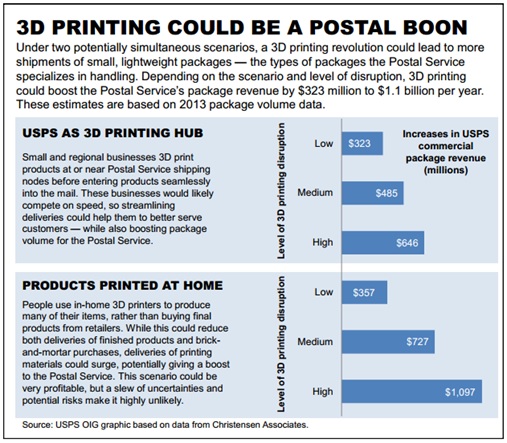New communication technologies have battered the business model of the United States Postal Service (USPS) over the past decade. A new report from the USPS Office of Inspector General analyzes the prospects of a new innovative technology – 3D printing—for the future financial health of the agency.
How 3D Printing will Change Manufacturing
3D printers use special inks made from plastics, metals, or polymers to build objects one layer at time. Rather than using a physical template they rely on digital designs that are easy to share and customize. 3D printing has the potential to democratize manufacturing. Instead of requiring specialized and expensive equipment 3D printers could enable people in every home to build the goods they want according to their own specifications.
3D Printing and the USPS

Source: USPS OIG
Two Potential Sources of New Revenue
The USPS envisions two scenarios that could both benefit the agency. Both rely on the Postal Service’s unique position to take advantage of the 3D printing trend. The USPS is miles beyond its competitors in terms of its last-mile delivery network. The USPS delivers to 153 million addresses throughout the country, six days a week. 3D printing could increase shipping revenues for two main reasons. The first reason is greater demand for the shipment of 3D printed products. In addition a new generation of makers will require the delivery of 3D printing supplies to their homes. The USPS stands to benefit from both scenarios. Critically, the Postal Service also has more than 60 million square feet of unused strategically placed space. The USPS could partner with 3D printing firms to create manufacturing hubs. These unused Postal Service buildings are typically adjacent to shipping facilities and have the capacity to provide the necessary electrical power and ventilation. These partnerships could also provide a much needed revenue boost to the USPS.
3D Printing not a Panacea for the USPS
Even in the most optimistic scenario analysts predict that 3D printing could increase USPS revenues about $1.743 billion. That figure certainly represents a boost to the Postal Service’s efforts to develop a new business model that is sustainable in the long-term. But, to survive the Postal Service will need to find other ways to balance their books. In 2013 the USPS had operating revenue of about $67 billion and operating expenses of about $72 billion. Their net loss for the year was $4.977 billion. The projected additional revenue from 3D printing would only cover 35 percent of the agency’s annual net loss.
3D printing will no doubt revolutionize manufacturing and usher in a new wave of innovation both in factories and garages across the country. It could also close a portion of the Postal Service’s deficit without laying off more workers or raising the price of stamps. But, if the agency is to survive other strategies beyond partnerships with 3D printers are necessary.


Commentary
Could 3D Printing Save the Postal Service?
July 21, 2014